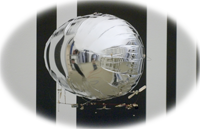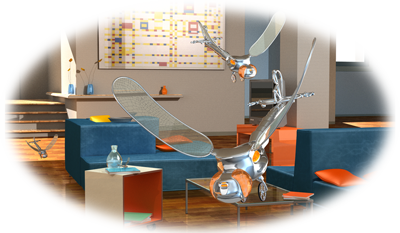
Bio-inspired Flying Robots
Experimental Synthesis of Autonomous Indoor Flyers

 |
Bio-inspired Flying Robots
|
 |
|
 |
Where to buy?EPFL Press |
 This book demonstrates how bio-inspiration can lead to fully autonomous flying robots without relying on external aids. Most existing aerial robots fly in open skies, far from obstacles, and rely on external beacons – mainly GPS – to localise and navigate. However, these robots are not able to fly at low altitude or in confined environments, and yet this poses absolutely no difficulty to insects. Indeed, flying insects display efficient flight control capabilities in complex environments despite their limited weight and relatively tiny brain size.
This book demonstrates how bio-inspiration can lead to fully autonomous flying robots without relying on external aids. Most existing aerial robots fly in open skies, far from obstacles, and rely on external beacons – mainly GPS – to localise and navigate. However, these robots are not able to fly at low altitude or in confined environments, and yet this poses absolutely no difficulty to insects. Indeed, flying insects display efficient flight control capabilities in complex environments despite their limited weight and relatively tiny brain size.
From sensor suite to control strategies, the literature on flying insects is reviewed from an engineering perspective in order to extract useful principles that are then applied to the synthesis of artificial indoor flyers. Artificial evolution is also utilised to search for alternative control systems and behaviours that match the constraints of small flying robots. Specifically, the basic sensory modalities of insects, vision, gyroscopes and airflow sense, are applied to develop navigation controllers for indoor flying robots. These robots are capable of mapping sensor information onto actuator commands in real time to maintain altitude, stabilize the course and avoid obstacles. The most prominent result of this novel approach is a 10-gram microflyer capable of fully autonomous operation in an office-sized room using fly-inspired vision, inertial and airspeed sensors.
This book is intended for all those interested in the autonomous robotics, working both in academic and industrial settings.
Book reference
|
Description |
YouTube movie |
Local movie |
Website |
Publica-tion year |
Related Work (Chap. 2) |
|||||
Fig. 2.1 |
3-gram Picoflyer by Petter Muren | 2005 |
|||
Fig. 2.2 |
The Seiko-Epson micro helicopter | 2004 |
|||
Fig. 2.3 |
The Naval Postgraduate School 14-gram biplane flapping thruster | 2003 |
|||
Fig. 2.4 |
The 15-gram flapping-wing DelFly | 2005 |
|||
Fig. 2.5 |
The Berkeley micromechanical flying insect | 2001 |
|||
Fig. 2.8 |
Melissa at Univ. of Zurich, a blimp capable of visual odometry indoors | 2001 |
|||
Fig. 2.9 |
The CNRS tethered helicopter demonstrating optic-flow-based altitude control | 2003 |
|||
Fig. 2.13 |
Drexel optic-flow-based indoor flyers | 2003 |
|||
Flying Insects (Chap. 3) |
|||||
Sect. 3.4 |
Blowfly body and head tracking using small sensor coils | 1998 |
|||
Robotic Platforms (Chap. 4) |
|||||
Fig. 4.5 |
Early prototypes of indoor slow flyers, including the C4 | 2001 |
|||
Fig. 4.6 |
The F2 prototype, a 30-gram indoor flyer | 2004 |
|||
Fig. 4.7 |
The 5-gram MicroCeline from DIDEL (non-robotic version of Fig. 4.7): remote-controlled in a small room | 2005 |
|||
Fig. 4.7 |
The 5-gram MicroCeline from DIDEL (non-robotic version of Fig. 4.7): flying down a corridor, entering rooms, landing on a table | 2005 |
|||
Optic-flow-based Control Strategies (Chap. 6) |
|||||
Fig. 6.11 |
F2 autonomous steering (collision avoidance) without altitude, nor speed control | 2004 |
|||
Fig. 6.18 |
MC2 fully autonomous flight | 2007 |
|||
Extra |
optiPilot: autonomous outdoor flight of a swinglet avoiding collisions with ground, trees, buildings and water | 2008 |
|||
Extra |
optiPilot: autonomous take-off and landing of a swinglet using seven computer mouse optic-flow sensors | 2009 |
|||
Evolved Control Strategies (Chap. 7) |
|||||
Fig. 7.7b |
Evolved Khepera/kevopic displaying vision-based collision avoidance | 2002 |
|||
Fig. 7.7d |
Evolved Khepera/kevopic displaying saccadic vision-based collision avoidance with backward movements | 2004 |
|||
Sect. 7.3.1 |
Evolved Blimp2b in simulation | 2004 |
|||
Fig. 7.9b |
Real Blimp2b evolved for vision-based autonomous steering | 2004 |
|||
Fig. 7.9d |
Evolved Blimp2b starting in a difficult situation and diplaying backward motion before recovery | 2004 |
|||
Sect. 7.3.2 |
Evolved Blimp2b encountering an unpredictable obstacle | 2004 |
|||
Extra |
Blimp2b evolved in simulation for a larger room and displaying efficient collision avoidance and wall following capabilities when tested in reality | 2005 |
|||
© Jean-Christophe Zufferey - Last update: 24.08.2009/jcz